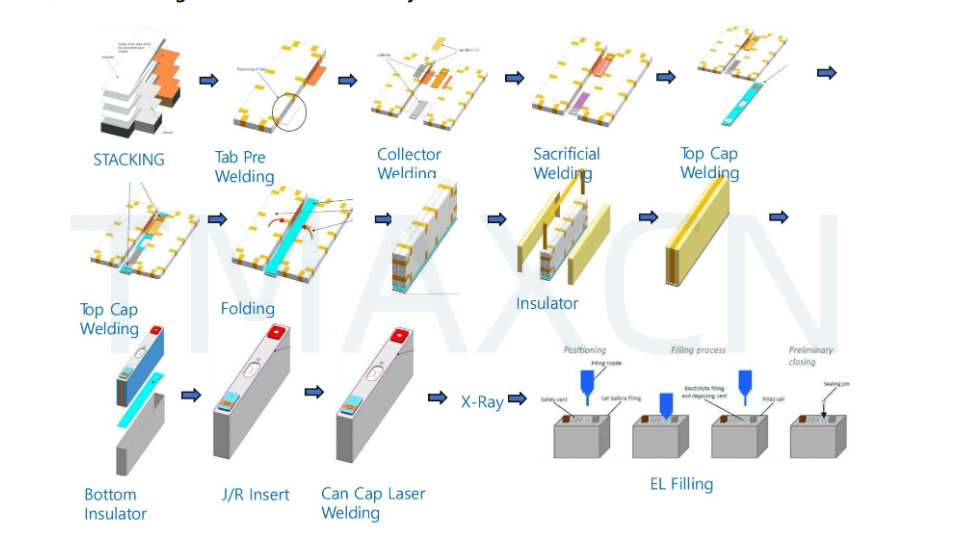Site Blog
contact us
- If you have questions, please contact us, all questions will be answered
- Email : David@tmaxcn.com
- Email : Davidtmaxcn@gmail.com
- Add : No. 39, Xinchang Road, Xinyang, Haicang Dist., Xiamen, Fujian, China (Mainland)
hot products
Introduction:
With the increasing demand for electric vehicles and energy storage, the battery industry is experiencing unprecedented growth opportunities. In this rapidly evolving field, prismatic batteries stand out for their high energy density and design flexibility. However, achieving high-quality and efficient production of prismatic batteries relies on the critical component known as prismatic cell scale line. This article explores the importance, working principles, and future development trends of prismatic cell assembly equipment.
1.Introduction to Prismatic Batteries:
As a mainstream rechargeable battery technology, prismatic batteries consist of multiple rectangular-shaped layers. Compared to traditional cylindrical and pouch batteries, prismatic batteries offer significant advantages in terms of energy density, design freedom, and installation efficiency. Therefore, prismatic batteries find widespread applications in electric vehicles, energy storage, and renewable energy sectors.
2.Overview of Prismatic Cell Assembly Equipment:
Prismatic cell assembly equipment refers to the key devices and tools used in the production of prismatic batteries. Its primary function is to automate the assembly of electrode films, separators, electrolytes, and other components, ensuring battery consistency and quality stability. This equipment typically includes electrode loading machines, coating machines, laminating machines, and sealing machines.
3.Key Components of prismatic cell lab line:
3.1 Electrode Loading Machine:
The electrode loading machine is responsible for accurately loading positive and negative electrode films onto the current collectors in the correct order and orientation. By employing high-precision mechanics and vision systems, the electrode loading machine achieves fast and accurate loading, maximizing production efficiency and quality.
3.2 Coating Machine:
The coating machine uniformly applies active materials and electrolytes onto the surface of electrode films, ensuring the battery's proper functioning. Precise coating thickness and uniformity are crucial for battery performance, and modern coating machines achieve high-quality coating through precise control and monitoring systems.
3.3 Laminating Machine:
The laminating machine is responsible for stacking the coated electrode films and separators, applying appropriate temperature and pressure to ensure a tight bond between the electrodes and the separator. Through precise control and pressure distribution techniques, the laminating machine achieves efficient and uniform lamination, maximizing battery performance and consistency.
3.4 Sealing Machine:
The sealing machine seals the assembled electrode films and separators to prevent electrolyte leakage and external contamination. Sealing machines typically employ high-temperature sealing or laser sealing techniques to ensure battery safety and longevity.
Workflow of prismatic cell pilot line
The workflow of prismatic cell assembly equipment typically includes steps such as electrode loading, coating, laminating, and sealing. These steps work in coordination, enabling automated and precise control to achieve efficient and consistent battery assembly.
Technological Challenges and Innovations in Prismatic Cell Assembly Equipment:
As battery technology continues to advance, prismatic cell assembly equipment faces various technological challenges, such as improving loading speed and accuracy, achieving more uniform coating and lamination, reducing energy consumption and waste generation, among others. To address these challenges, innovative solutions emerge, including machine vision technology, automation control systems, and intelligent manufacturing.
Application Areas and Future Development Trends:
Prismatic cell assembly equipment finds wide applications in electric vehicles, energy storage, and renewable energy sectors. With the expanding electric vehicle market and emerging applications, prismatic cell assembly equipment will continue to evolve. Future trends include higher production speed and quality, more intelligent manufacturing processes, and the use of environmentally friendly materials and energy.
Prismatic cell assembly equipment plays a critical role in the development of the battery industry. Through automation and precise control, this equipment ensures high-quality and efficient production of prismatic batteries. With the rapid growth of electric vehicles and energy storage, prismatic cell assembly equipment will continue to drive battery technology advancements and sustainable development.
 ru
ru

 Iris@tmaxcn.com
Iris@tmaxcn.com David@tmaxcn.com
David@tmaxcn.com +86 13174506016
+86 13174506016 18659217588
18659217588